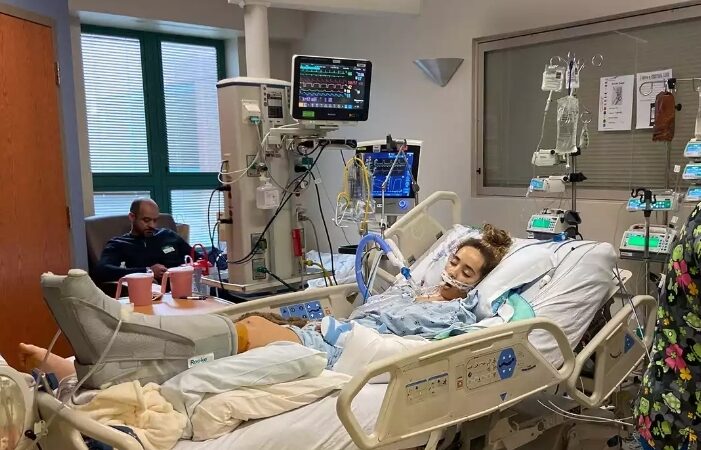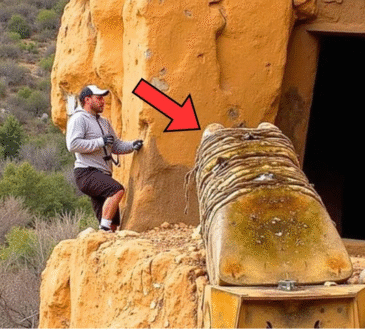How 17-Year-Old Recovers from Near-Death Experience with Flesh-Eating Bacteria- Touching Story

After a life-saving transport, multiple surgeries and months of physical therapy, Kiger-Camilo has fully recovered from necrotizing fasciitis, a kind of flesh-eating bacteria that almost killed her.
It all started at a dance competition one weekend in March when Kiger-Camilo noticed an open wound on her foot. “As a dancer, you get cuts on your foot,” she told PEOPLE. “I started to notice some pain in my left foot, which is normal — as an athlete, there’s always pain.”
But by the time she got home from the competition, she was in so much pain that she collapsed. “My parents could tell something wasn’t right,” she says. “With COVID and everything, we were scared of waiting in the ER for hours. But thank God we decided to go.”
At the community hospital, the doctors couldn’t see anything wrong with Kiger-Camilo’s foot on the surface, and all her blood tests were coming back normal. The doctors were worried about something called compartment syndrome, in which blood gets trapped in an enclosed muscle space and creates excessive pressure in the area — “it’s super dangerous, but you don’t really have compartments in your foot, which is where all my pain was,” Kiger-Camilo explains.
Not only was she in intense pain, but her blood pressure was dangerously low, and her fever rose to over 100 degrees. At that point, Kiger-Camilo’s parents, Rebecca Kiger and David Camilo, demanded she be transferred to another hospital. Their daughter was air-lifted to WVU Children’s Hospital and she received life-saving medication on the flight. Within an hour of arriving at the hospital, she was in the operating room.
The doctors identified her condition as necrotizing fasciitis, a rare flesh-eating bacteria with a mortality rate from 11-22%, with rates from 16-33% when it coincides with streptococcal toxic shock syndrome (STSS), according to the CDC.
The bacteria releases an endotoxin into the host’s body, leading the host to go into septic shock. “Your body knows that it has an infection, so it opens up all the valves, like your blood vessels and the vessels that transport other fluids that help with healing and cleansing,” Kiger-Camilo explains. “But once all of those valves are open, your vital organs can’t get any blood, which is your brain, your liver, your heart — basically your body starts to shut down. That’s what’s so dangerous about it.”
“With necrotizing fasciitis, the two most common things are death and amputation,” Kiger-Camilo says. “It’s something that eats you from the inside out.”
Kiger-Camilo says the doctors believe she contracted the bacteria from the cut on her foot at the dance competition. “It’s on skin, on doors, on floors — it’s everywhere,” she says of the necrotizing fasciitis bacteria, which is the same kind of streptococcal bacteria that leads to strep throat. “It’s just kind of a perfect storm to get it into a cut and for it to get trapped there and to start festering and multiplying.”
While Kiger-Camilo was in the hospital, her parents took time off work to stay with her. A family friend set up a GoFundMe for her family to be able to pay for the transport as well as cover the cost of taking time off work. The fundraiser amassed over $52,000
“Our community really just was incredible,” Kiger-Camilo says. “We’ll probably have to use a lot of that for the helicopter ride, but all of the support that we received, even if it wasn’t monetary, just made us feel very loved and helped a lot in a really difficult time for my family.”
After undergoing multiple surgeries, in which the doctors made cuts all the way up her leg so they could pinpoint the infection, and a skin graft, Kiger-Camilo’s surgeons were able to save all her tendons and muscles. “It was a miracle,” she says. “It looks a little bit like Frankenstein’s foot, but it’s fully functioning.”
When she first returned home in may, she had to use a walker just to get from her bedroom to the bathroom. But now, after months of weight lifting and physical therapy, she is able to walk and even run.
“I’m definitely going to start dancing again,” she says. “I’ll start dancing in the next few months, hopefully competing again because this is my senior year.”
Though Kiger-Camilo had to miss the final two-and-a-half months of her junior year of high school, her school is helping her finish the curriculum. She is currently working on a capstone project about necrotizing fasciitis, incorporating her own experience into the personal narrative portion. She was also able to interview her own medical team about the disease for the scientific part.
Kiger-Camilo has her heart set on attending the Naval Academy after she graduates high school, but now her plans for the future also include going into the medical field. “[My doctors] inspired me not to just be a better human, but now I want to go into the medical field and help people the way that I was helped — especially kids,” she says.
Though Kiger-Camilo endured months of pain and nearly died, she said she is grateful for the positivity and new outlook on life that the experience gave her. “I’m definitely super grateful for how this experience strengthened my relationship with my family and my faith,” she says. “On the surface I think it looks like a really bad experience, but it brought a lot of good into my life.”
“Once you’ve really struggled,” she says, “it’s much easier to see the beauty in life.”




